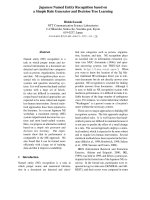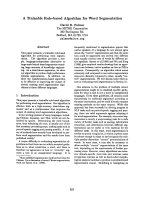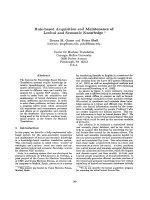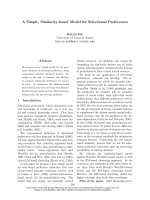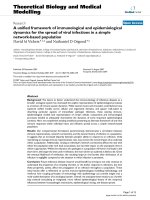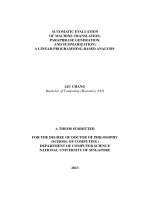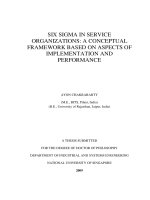Absulute momentum a simple rule based strategy and universal trend following overday
Bạn đang xem bản rút gọn của tài liệu. Xem và tải ngay bản đầy đủ của tài liệu tại đây (692.52 KB, 33 trang )
Absolute Momentum: A Simple Rule-Based Strategy and Universal
Trend-Following Overlay
Gary Antonacci
Portfolio Management Consultants1
April 10, 2014
Abstract
There is a considerable body of research on relative strength price momentum but much less on
absolute momentum, also known as time series momentum.2 In this paper, we explore the
practical side of absolute momentum. We first explore its sole parameter - the formation, or look
back, period. We then examine the reward, risk, and correlation characteristics of absolute
momentum applied to stocks, bonds, and real assets. We finally apply absolute momentum to a
60/40 stock/bond portfolio and a simple risk parity portfolio. We show that absolute momentum
can effectively identify regime change and add significant value as an easy-to-implement, rulebased approach with many potential uses as both a stand- alone program and trend-following
overlay.
1
2
We prefer the term absolute momentum because all momentum is based on time series, and practitioners are used
to hearing about relative and absolute returns. Relative and absolute momentum follows the same logic.
1
Electroniccopy
copy available
available at:
Electronic
at: /> />
1. Introduction
The momentum effect is one of the strongest and most pervasive financial phenomena
(Jegadeesh and Titman (1993), (2001)). Researchers have verified its value with many different
asset classes, as well as across groups of assets (Blitz and Van Vliet (2008), Asness, Moskowitz
and Pedersen (2012)). Since its publication, relative strength momentum has held up out-ofsample going forward in time (Grundy and Martin (2001), Asness et al (2012)) and back to the
year 1801 (Geczy and Samonov (2012)).
In addition to relative strength momentum, in which an asset's performance relative to its
peers predicts its future relative performance, momentum also works well on an absolute or time
series basis in which an asset's own past return predicts its future performance. In absolute
momentum, we look only at an asset's excess return over a given look back period. In absolute
momentum, there is significant positive auto-covariance between an asset's return in the
following month and its past one-year excess return (Moskowitz, Ooi and Pedersen (2012)).
Absolute momentum is therefore trend following by nature. Trend-following methods, in
general, have slowly achieved recognition and acceptance in the academic community (Brock,
Lakonishok and LeBaron (1992), Lo, Mamaysky, and Wang (2000), Zhu and Zhou (2009), Han,
Yang, and Zhou (2011)).
Absolute momentum appears to be just as robust and universally applicable as relative
momentum. It performs well in extreme market environments, across multiple asset classes
(commodities, equity indexes, bond markets, currency pairs), and back in time to the turn of the
century (Hurst, Ooi, and Pedersen (2012)).
Despite an abundance of momentum research over the past 20 years, no one is sure why it
works. Brown and Jennings (1989) developed a rational equilibrium-based model using historical
2
Electroniccopy
copy available
available at:
Electronic
at: /> />
prices with technical analysis. More recently, Zhou and Zhu (2014) identified equilibrium returns
due to the risk sharing function provided by trend following trading rules, such as absolute
momentum.
The most common explanations for both momentum and trend-following profits,
however, have to do with behavioral factors, such as anchoring, herding, and the disposition
effect (Tversky and Kahneman (1974), Barberis, Shleifer, and Vishny (1998), Daniel,
Hirshleifer, and Subrahmanyam (1998), Hong and Stein (1999), Frazzini (2006)).
In anchoring, investors are slow to react to new information, which leads initially to
under-reaction. In herding, buying begets more buying and causes prices to over react and move
beyond fundamental value after the initial under-reaction. Through the disposition effect,
investors sell winners too soon and hold losers too long. This creates a headwind making trends
continue longer before reaching true value.
Risk management schemes that sell in down markets and buy in up markets can also
cause trends to persist (Garleanu and Pedersen (2007)), as can confirmation bias, which causes
investors to look at recent price moves as representative of the future. This then leads them to
move money into investments that have recently appreciated, thus causing trends to continue
further (Tversky and Kahneman (1974)). Behavioral biases are deeply rooted, which may explain
why momentum profits have persisted and may continue to persist.
In this paper, we focus on absolute momentum because of its simplicity and the
advantages it holds for long-only investing. We can apply absolute momentum to any asset or
portfolio of assets without losing any of the contributory value of other assets. With relative
strength momentum, on the other hand, we exclude or reduce the influence of some assets from
3
Electronic copy available at: />
the active portfolio. This can diminish the benefits that come from multi-asset diversification and
lead to opportunity loss by excluding lagging assets that may suddenly start outperforming.
The second advantage of absolute momentum is its superior ability to reduce downside
volatility by identifying regime change. Both relative and absolute momentum can enhance
return, but absolute momentum, unlike relative momentum, is also effective in reducing the
downside exposure associated with long-only investing (Antonacci (2012)).
The next section of this paper describes our data and the methodology we use to work
with absolute momentum. The following section explores the formation period used for
determining absolute momentum. After that, we show what effect absolute momentum has on
the reward, risk, and correlation characteristics of a number of diverse markets, compared to a
buy and hold approach. Finally, we apply absolute momentum to two representative multi-asset
portfolios -- a 60/40 balanced stock/bond portfolio and a simple, diversified risk parity portfolio.
2. Data and Methodology
All monthly data begins in January 1973, unless otherwise noted, and includes interest
and dividends. For equities, we use the MSCI (Morgan Stanley Capital International) US and
MSCI EAFE (Europe, Australia, and Far East) indexes. These are free float adjusted market
capitalization weightings of large and midcap stocks. For fixed income, we use the Barclays
Capital Long U.S. Treasury, Intermediate U.S. Treasury, U.S. Credit, U.S. High Yield Corporate,
U.S. Government & Credit, and U.S. Aggregate Bond indexes. The beginning date of the high
yield index is July 1, 1983, and the start date of the aggregate bond index is January 1, 1976. For
dates prior to January 1976, we substitute the Government & Credit index for the Aggregate
Bond index, since they track one another closely. For Treasury bills, we use the monthly returns
on 90-day U.S. Treasury bill holdings. For real assets, we use the FTSE NAREIT U.S. Real
4
Electronic copy available at: />
Estate index, the Standard &Poor's GSCI (formally Goldman Sachs Commodity Index), and
monthly gold returns based on the month-end closing London PM gold fix.
Although there are more complicated methods for determining absolute momentum
(Baltas and Kosowski (2012)), our strategy simply defines absolute momentum as being positive
when the excess return (asset return less the Treasury bill return) over the formation (look back)
period is positive. We hold a long position in our selected assets during these times. When
absolute momentum turns negative (i.e., an asset's excess return turns negative), our baseline
strategy is to exit the asset and switch into 90-day U.S. Treasury bills until absolute momentum
again becomes positive. Treasury bills are a safe harbor for us during times of market stress.
We reevaluate and adjust positions monthly.3 The number of transactions per year into or
out of Treasury bills ranges from a low of 0.33 for REITs to a high of 1.08 for high-yield bonds.
We deduct 20 basis points for transaction costs for each switch into or out of Treasury bills.4
Maximum drawdown is the greatest peak-to-valley equity erosion on a month-end basis.
3. Formation Period
Table 1 shows the Sharpe ratios for formation periods ranging from 2 to 18 months. Since
our data begins in January 1973 (except for high yield bonds, which begin in July 1983) and 18
months is the maximum formation period that we consider, results extend from July 1974
through December 2012. We have highlighted the highest Sharpe ratios for each asset.
Best results cluster at 12 months. As a check on this, we segment our data into subsamples and
find the highest Sharpe ratios for each asset in every decade from 1974 through 2012.
3
Stock market indices and other assets are less subject to liquidity and microstructure issues than individual stocks,
so we do not need to skip a month with our look back periods.
4
There are no transaction costs deducted for monthly rebalancing of the momentum or any of the benchmark
portfolios.
5
Electronic copy available at: />
Figure 1 shows the number of times the Sharpe ratio is highest, or within two percentage points
of being highest, for each look back period across all the decades.
Table 1 Formation Period Sharpe Ratios
MSCI US
EAFE
TBOND
CREDIT
HI YLD
REIT
GSCI
GOLD
18
.41
.33
.40
.75
.70
.65
.04
.39
16
.43
.32
.42
.80
.87
.71
.04
.35
14
.45
.35
.45
.70
.82
.72
.09
.35
12
.56
.41
.54
.74
.92
.69
.20
.42
10
.46
.45
.38
.80
.66
.63
.09
.39
8
.44
.32
.36
.81
.69
.63
-.08
.37
6
.41
.38
.33
.69
.82
.87
-.11
.32
4
.38
.36
.42
.71
.77
.68
.13
.30
2
.23
.46
.40
.66
.77
.63
.06
.21
Figure 1 Best Formation Periods 1974-2012
9
8
O
c
c
u
r
a
n
c
e
s
7
6
5
4
3
2
1
0
18
16
14
12
10
8
6
4
2
Best Number of Look Back Months
Both our aggregated and segmented results coincide with the best formation periods of
relative momentum, which extend from 3 to 12 months and cluster at 12 months (Jegadeesh and
6
Electronic copy available at: />
Titman (1993)).5 Many momentum research papers use a 12-month formation period with a onemonth holding period as a benchmark strategy for research purposes. Given its dominance here
and throughout the literature, we also use a 12-month formation period as our benchmark
strategy. This should minimize transaction costs and the risk of data snooping.
4. Absolute Momentum Characteristics
Table 2 is a performance summary of each asset and the median of all the assets, with and
without 12-month absolute momentum, from January 1974 through December 2012.
Table 2 Absolute Momentum Results 1974-2012
Annual
Return
Annual
Std Dev
Annual
Sharpe
Maximum
Drawdown
% Profit
Months
12.26
11.62
11.57
15.74
.55
.37
-22.90
-50.65
75
61
10.39
11.56
11.82
17.53
.39
.33
-25.14
-56.40
78
60
10.08
9.74
8.43
10.54
.52
.39
-12.92
-20.08
77
61
8.91
8.77
4.72
7.18
.70
.44
-8.70
-19.26
82
67
HI YLD No Mom
9.97
10.05
4.76
8.70
.90
.50
-7.14
-33.31
88
75
REIT Abs Mom
14.16
11.74
.69
-19.97
REIT No Mom
14.74
17.25
.50
-68.30
75
62
GSCI Abs Mom
8.24
15.46
.17
-48.93
81
GSCI No Mom
4.93
19.96
-.02
-61.03
54
GOLD Abs Mom
GOLD No Mom
13.68
9.44
16.62
19.97
.46
.19
-24.78
-61.78
81
53
MEDIAN Abs Mom
10.25
11.66
.53
-21.43
79
MEDIAN No Mom
9.90
16.48
.38
-53.53
61
MSCI US Abs Mom
MSCI US No Mom
EAFE Abs Mom
EAFE No Mom
TBOND Abs Mom
TBOND No Mom
CREDIT Abs Mom
CREDIT No Mom
HI YLD Abs Mom
5
Cowles and Jones (1937) were the first to point out the profitable look back period of 12 months using U.S. stock
market data from 1920 through 1935. Moskowitz et al (2012) also found a 12-month look back period best when
applying absolute momentum to 58 liquid futures markets from 1965 through 2009.
7
Electronic copy available at: />
Figure 2 shows the Sharpe ratios and percentage of profitable months for these assets,
with and without 12-month absolute momentum. Figure 3 presents the percentage of profitable
months, and Figure 4 shows maximum monthly drawdown. Every asset has a higher Sharpe
ratio, lower maximum drawdown, and higher percentage of profitable months with 12-absolute
momentum over this 38-year period.6
Figure 2 Asset Sharpe Ratios 1974-2012
MSCI US
EAFE
TBOND
CREDIT
HI YIELD
REIT
GSCI
GOLD
Abs No Abs No Abs No Abs No Abs No Abs No Abs No Abs No
Mom Mom Mom Mom Mom Mom Mom Mom Mom Mom Mom Mom Mom Mom Mom Mom
1.10
0.90
0.70
0.50
0.30
0.10
-0.10
6
The percentage of months each asset has positive absolute momentum: MSCI US 72%, MSCI EAFE 65%,
TBOND 66%, CREDIT 56%, HI YIELD 68%, REIT 78%, GSCI 50%, and GOLD 53%.
8
Electronic copy available at: />
Figure 3 Percentage of Profitable Months 1974-2012
100%
90%
80%
70%
60%
50%
40%
30%
20%
10%
0%
Abs No Abs No Abs No Abs No Abs No Abs No Abs No Abs No
Mom Mom Mom Mom Mom Mom Mom Mom Mom Mom Mom Mom Mom Mom Mom Mom
MSCI US
EAFE
TBOND
CREDIT
HI YIELD
REIT
GSCI
GOLD
Figure 4 Maximum Monthly Drawdown 1974-2012
0%
-10%
-20%
-30%
-40%
-50%
-60%
-70%
MSCI US
EAFE
TBOND
CREDIT
HI YIELD
REIT
GSCI
9
Electronic copy available at: />
No Mom
Abs Mom
No Mom
Abs Mom
No Mom
Abs Mom
No Mom
Abs Mom
No Mom
Abs Mom
No Mom
Abs Mom
No Mom
Abs Mom
No Mom
Abs Mom
-80%
GOLD
Table 3 shows the monthly correlations between our assets, with and without the
application of absolute momentum. The average correlation of the eight assets without absolute
momentum is 0.22, and with absolute momentum, it is 0.21. There is no indication from our data
that absolute momentum, in general, increases correlation. This has positive implications for
applying absolute momentum to multi-asset portfolios, which we look at next.
Table 3 Monthly Correlations 1974-2012
No Momentum
MSCI US
EAFE
TBOND
CREDIT
HI YLD
REIT
GSCI
GOLD
.63
.11
.26
.43
.58
.10
.01
.03
.12
.37
.48
.18
.19
.67
.12
.05
-.10
.01
.40
.15
.04
-.02
.32
.07
-.04
.11
.07
EAFE
TBOND
CREDIT
HI YLD
REIT
GSCI
.27
w/ 12-Month Absolute Momentum
MSCI US
EAFE
TBOND
EAFE
TBOND
CREDIT
HI YLD
REIT
GSCI
GOLD
.49
.05
.35
.45
.45
.14
.04
.03
.26
.31
.29
.13
.11
.81
.04
-.03
-.04
-.02
.38
.28
-.01
.05
.41
.09
.02
.13
.12
CREDIT
HI YLD
REIT
GSCI
.30
Figures 5 through 12 are log-scale growth charts of each asset with a starting value of
100.
10
Electronic copy available at: />
Figure 5 MSCI US 1974-2012
MSCI US w/Abs Mom
MSCI US
5000
500
50
1
9
7
4
1
9
7
5
1
9
7
6
1
9
7
7
1
9
7
8
1
9
7
9
1
9
8
0
1
9
8
1
1
9
8
2
1
9
8
3
1
9
8
4
1
9
8
5
1
9
8
6
1
9
8
7
1
9
8
8
1
9
8
9
1
9
9
0
1
9
9
1
1
9
9
2
1
9
9
3
1
9
9
4
1
9
9
5
1
9
9
6
1
9
9
7
1
9
9
8
1
9
9
9
2
0
0
0
2
0
0
1
2
0
0
2
2
0
0
3
2
0
0
4
2
0
0
5
2
0
0
6
2
0
0
7
2
0
0
8
2
0
0
9
2
0
1
0
2
0
0
6
2
0
0
7
2
0
0
8
2
0
0
9
2
0
1
0
2
0
1
1
2
0
1
2
Figure 6 MSCI EAFE 1974-2012
MSCI EAFE w/Abs Mom
MSCI EAFE
5000
500
50
1
9
7
4
1
9
7
5
1
9
7
6
1
9
7
7
1
9
7
8
1
9
7
9
1
9
8
0
1
9
8
1
1
9
8
2
1
9
8
3
1
9
8
4
1
9
8
5
1
9
8
6
1
9
8
7
1
9
8
8
1
9
8
9
1
9
9
0
1
9
9
1
1
9
9
2
1
9
9
3
1
9
9
4
1
9
9
5
1
9
9
6
1
9
9
7
1
9
9
8
1
9
9
9
2
0
0
0
2
0
0
1
2
0
0
2
2
0
0
3
2
0
0
4
2
0
0
5
11
Electronic copy available at: />
2
0
1
1
2
0
1
2
Figure 7 U.S. Treasury Bonds 1974-2012
Treasury Bond w/Abs Mom
Treasury Bond
5000
500
50
5
1
9
7
4
1
9
7
5
1
9
7
6
1
9
7
7
1
9
7
8
1
9
7
9
1
9
8
0
1
9
8
1
1
9
8
2
1
9
8
3
1
9
8
4
1
9
8
5
1
9
8
6
1
9
8
7
1
9
8
8
1
9
8
9
1
9
9
0
1
9
9
1
1
9
9
2
1
9
9
3
1
9
9
4
1
9
9
5
1
9
9
6
1
9
9
7
1
9
9
8
1
9
9
9
2
0
0
0
2
0
0
1
2
0
0
2
2
0
0
3
2
0
0
4
2
0
0
5
2
0
0
6
2
0
0
7
2
0
0
8
2
0
0
9
2
0
1
0
2
0
1
1
2
0
1
2
2
0
0
6
2
0
0
7
2
0
0
8
2
0
0
9
2
0
1
0
2
0
1
1
2
0
1
2
Figure 8 U.S. Credit Bonds 1974-2012
Credit Bond w/Abs Mom
Credit Bond
5000
500
50
1
9
7
4
1
9
7
5
1
9
7
6
1
9
7
7
1
9
7
8
1
9
7
9
1
9
8
0
1
9
8
1
1
9
8
2
1
9
8
3
1
9
8
4
1
9
8
5
1
9
8
6
1
9
8
7
1
9
8
8
1
9
8
9
1
9
9
0
1
9
9
1
1
9
9
2
1
9
9
3
1
9
9
4
1
9
9
5
1
9
9
6
1
9
9
7
1
9
9
8
1
9
9
9
2
0
0
0
2
0
0
1
2
0
0
2
2
0
0
3
2
0
0
4
2
0
0
5
12
Electronic copy available at: />
Figure 9 U.S. High Yield Bonds 1984-2012
High Yield w/Abs Mom
High Yield
5000
500
50
5
1
9
8
4
1
9
8
5
1
9
8
6
1
9
8
7
1
9
8
8
1
9
8
9
1
9
9
0
1
9
9
1
1
9
9
2
1
9
9
3
1
9
9
4
1
9
9
5
1
9
9
6
1
9
9
7
1
9
9
8
1
9
9
9
2
0
0
0
2
0
0
1
2
0
0
2
2
0
0
3
2
0
0
4
2
0
0
5
2
0
0
6
2
0
0
7
2
0
0
8
2
0
0
9
2
0
1
0
2
0
1
1
Figure 10 U.S. REITs 1974-2012
REIT w/Abs Mom
REIT
50000
5000
500
50
1
9
7
4
1
9
7
5
1
9
7
6
1
9
7
7
1
9
7
8
1
9
7
9
1
9
8
0
1
9
8
1
1
9
8
2
1
9
8
3
1
9
8
4
1
9
8
5
1
9
8
6
1
9
8
7
1
9
8
8
1
9
8
9
1
9
9
0
1
9
9
1
1
9
9
2
1
9
9
3
1
9
9
4
1
9
9
5
1
9
9
6
1
9
9
7
1
9
9
8
1
9
9
9
2
0
0
0
2
0
0
1
2
0
0
2
2
0
0
3
2
0
0
4
2
0
0
5
2
0
0
6
2
0
0
7
2
0
0
8
13
Electronic copy available at: />
2
0
0
9
2
0
1
0
2
0
1
1
2
0
1
2
2
0
1
2
Figure 11 S&P GSCI 1974-2012
GSCI w/Abs Mom
GSCI
5000
500
50
1
9
7
4
1
9
7
5
1
9
7
6
1
9
7
7
1
9
7
8
1
9
7
9
1
9
8
0
1
9
8
1
1
9
8
2
1
9
8
3
1
9
8
4
1
9
8
5
1
9
8
6
1
9
8
7
1
9
8
8
1
9
8
9
1
9
9
0
1
9
9
1
1
9
9
2
1
9
9
3
1
9
9
4
1
9
9
5
1
9
9
6
1
9
9
7
1
9
9
8
1
9
9
9
2
0
0
0
2
0
0
1
2
0
0
2
2
0
0
3
2
0
0
4
2
0
0
5
2
0
0
6
2
0
0
7
2
0
0
8
2
0
0
9
2
0
1
0
2
0
1
1
2
0
1
2
2
0
0
3
2
0
0
4
2
0
0
5
2
0
0
6
2
0
0
7
2
0
0
8
2
0
0
9
2
0
1
0
2
0
1
1
2
0
1
2
Figure 12 London Gold 1974-2012
Gold w/Abs Mom
Gold
100000
10000
1000
100
10
1
1
9
7
4
1
9
7
5
1
9
7
6
1
9
7
7
1
9
7
8
1
9
7
9
1
9
8
0
1
9
8
1
1
9
8
2
1
9
8
3
1
9
8
4
1
9
8
5
1
9
8
6
1
9
8
7
1
9
8
8
1
9
8
9
1
9
9
0
1
9
9
1
1
9
9
2
1
9
9
3
1
9
9
4
1
9
9
5
1
9
9
6
1
9
9
7
1
9
9
8
1
9
9
9
2
0
0
0
2
0
0
1
2
0
0
2
14
Electronic copy available at: />
5. 60/40 Balanced Portfolio
Given the ability of 12-month absolute momentum to improve risk-adjusted
performance over a broad range of individual assets, it is natural to wonder how absolute
momentum might affect our multi-asset portfolios. One of the simplest multi-asset portfolios
is the 60% stocks and 40% bonds mix (60/40) that institutional investors adopted in the mid1960s, based on their observation of stock and bond returns from 1926 through 1965. Table 4
shows how a 60/40 portfolio of the US MSCI and US Treasury indexes, as well as the US
MSCI index, have performed since 1974, with and without the addition of 12-month absolute
momentum.
Table 4 60/40 Balanced Portfolio Performance 1974-2012
60/40
w/Abs Mom
60/40
No Mom
MSCI US
w/Abs Mom
MSCI US
No Mom
Annual
Return
11.52
Annual
Std Dev
7.88
Annual
Sharpe
.72
Maximum
Drawdown
-13.45
% Profit
Months
74
Correlation
to S&P500
.67
Correlation to
10 Yr Bond
.37
10.86
10.77
.47
-29.32
63
.92
.46
12.26
11.57
.55
-22.90
75
.74
.13
11.62
15.74
.37
-50.65
61
1.00
.10
The 60/40 portfolio without momentum shows some reduction in volatility and
drawdown compared to an investment solely in US stocks. However, the strong 0.92 monthly
correlation of the 60/40 portfolio with the S&P 500 shows that the 60/40 portfolio has retained
most of the market risk of stocks. Because stocks are much more volatile than bonds, stock
market movement dominates the risk in a 60/40 portfolio. From a risk perspective, the regular
60/40 portfolio is, in fact, mostly an equity portfolio, since stock market variation explains most
of the variation in performance of the 60/40 portfolio.
15
Electronic copy available at: />
The MSCI US index with the addition of absolute momentum has a 0.74 correlation to
the S&P 500, which is lower than the 0.92 correlation of the 60/40 index to the S&P 500. MSCI
US with absolute momentum does a better job than the 60/40 portfolio in reducing portfolio
drawdown, while also providing higher returns. The correlation to the S&P 500 of the 60/40
portfolio using 12-month absolute momentum drops to 0.67 from 0.92.7 The 60/40 portfolio with
absolute momentum retains the same return as the normal MSCI US Index, but with only half the
volatility. The maximum drawdown drops by more than 70%.
Figure 13 shows the maximum 3, 6, and 12-month drawdown of the MSCI US Index and
the 60/40 portfolios, with and without 12-month absolute momentum. Figure 14 is a rolling fiveyear window of the maximum drawdown of the same portfolios.
Figure 13 1 to 12-Month Maximum Drawdown 1974-2012
MSCI US
60-40 Portfolio
60-40 w/Abs Mom
0
-5
-10
-15
-20
-25
-30
-35
-40
-45
1 Month
3 Month
6 Month
7
12 Month
For the 10 years ending December 2012, the monthly correlation of the absolute momentum 60/40 portfolio to the
S&P 500 index was .53, compared to a correlation of .87 for the normal 60/40 portfolio to the S&P 500 index.
16
Electronic copy available at: />
Figure 14 Rolling 5-Year Maximum Drawdown 1979-2012
60-40 w/AbsMom
60-40 Portfolio
MSCI US
0
-10
-20
-30
-40
-50
-60
1
9
7
9
1
9
8
0
1
9
8
1
1
9
8
2
1
9
8
3
1
9
8
4
1
9
8
5
1
9
8
6
1
9
8
7
1
9
8
8
1
9
8
9
1
9
9
0
1
9
9
1
1
9
9
2
1
9
9
3
1
9
9
4
1
9
9
5
1
9
9
6
1
9
9
7
1
9
9
8
1
9
9
9
2
0
0
0
2
0
0
1
2
0
0
2
2
0
0
3
2
0
0
4
2
0
0
5
2
0
0
6
2
0
0
7
2
0
0
8
2
0
0
9
2
0
1
0
2
0
1
1
2
0
1
2
The traditional 60/40 portfolio offers little in the way of risk-reducing diversification,
even though it looks balanced from the perspective of dollars invested in each asset class. From
1900 through 2012, the probability of the 60/40 portfolio having a negative real return has been
35% in any one year, 20% over any five years, and 10% over any 10 years8. Its real maximum
drawdown was 66%. Adding a simple 12-month absolute momentum overlay to the 60/40
portfolio achieves market-level returns with a more reasonable amount of downside risk. Figure
15 shows the consistency of the 12-month absolute momentum 60/40 portfolio compared to the
traditional 60/40 portfolio. The trend following, market-timing feature of absolute momentum
may be more valuable now than in the past, when the world was less inter-connected, asset
correlations were lower, and diversification alone was better able to reduce downside exposure.
8
Data is from the Robert Shiller website: />
17
Electronic copy available at: />
Figure 15 60/40 Balanced Portfolios 1974-2012
60-40 Portfolio w/Abs Mom
60-40 Portfolio
5000
500
50
1
9
7
4
1
9
7
5
1
9
7
6
1
9
7
7
1
9
7
8
1
9
7
9
1
9
8
0
1
9
8
1
1
9
8
2
1
9
8
3
1
9
8
4
1
9
8
5
1
9
8
6
1
9
8
7
1
9
8
8
1
9
8
9
1
9
9
0
1
9
9
1
1
9
9
2
1
9
9
3
1
9
9
4
1
9
9
5
1
9
9
6
1
9
9
7
1
9
9
8
1
9
9
9
2
0
0
0
2
0
0
1
2
0
0
2
2
0
0
3
2
0
0
4
2
0
0
5
2
0
0
6
2
0
0
7
2
0
0
8
2
0
0
9
2
0
1
0
2
0
1
1
2
0
1
2
6. Parity Portfolios
The usual way of dealing with the strong equities tilt of the 60/40 portfolio is to diversify
more broadly and/or dedicate a larger allocation to fixed income investments. Endowment funds,
for example, often diversify into a number of specialized areas, such as private equity, hedge
funds, and other higher risk alternative investments. Some risk parity programs also diversify
broadly. In addition, risk parity portfolios attempt to equalize the risk across different asset
classes by allocating more capital to relatively lower volatility assets, like fixed income. A stockbond portfolio, for example, would require at least a 70% allocation to bonds in order to have
equal risk exposure from bonds and equities.
18
Electronic copy available at: />
A common way to construct risk parity portfolios is to weight each asset's position size
by the inverse of its volatility.9 This normalizes risk exposure across all asset classes. But there
are several problems with that approach. First, one somehow has to determine the best look back
interval and frequency for measuring volatility. This introduces data snooping bias. Second,
volatility and correlation are inherently unstable and non-stationary. Their use therefore
introduces additional estimation risk and potential portfolio instability. We take a simpler
approach that accomplishes much the same thing as traditional risk parity. Starting with the
MSCI US and long Treasury bond indexes used in our 60/40 portfolio, we add REITs, credit
bonds, and gold, with an equal weighting given to each asset class.10 We use credit bonds to
increase the fixed income exposure of the portfolio. Credit bonds diversify our fixed income
allocation by providing some credit risk premium with less duration risk than long Treasuries.
REITs give us exposure to real assets with some additional risk exposure to equities. Gold gives
us real asset exposure that is different from real estate.11 Gold has the highest volatility, and so it
represents only 20% of our parity portfolio, whereas bonds receive the largest allocation of 40%
from being represented twice in the portfolio. Exposure to equities is somewhere between gold
and bonds.
By structuring our portfolio purposefully to begin with, we are able to balance our risk
exposure between fixed income, equities, and real assets non-parametrically without incurring
any added estimation risk. We will see that the addition of absolute momentum to our parity
portfolio reduces and equalizes risk exposure across all asset classes.
9
Some use covariance instead of volatility in order to take into account asset correlations.
DeMiguel, Garlappi, and Uppal (2009) test 14 out-of-sample allocation models on 7 datasets and find that none
have higher Sharpe ratios or certainty equivalent returns than equal weighting. Gains from optimal diversification
with more complicated models are more than offset by estimation errors.
11
We use gold instead of commodities because of the possible lack of risk premia and substantial front-running
rollover costs associated with commodity index futures (Daskalaki and Skiadopoulus (2011), Mou (2011)).
10
19
Electronic copy available at: />
Table 5 shows the correlations of the S&P 500, U.S.10 Year Treasury, and GSCI
Commodity indexes to the 60/40 and parity portfolios, both with and without 12-month absolute
momentum. Our parity portfolio with 12-month absolute momentum shows a modest and nearly
equal correlation to both stocks and bonds. Because of the downside risk attenuation through
absolute momentum, we have achieved risk parity while limiting fixed income assets to no more
than 40% of our portfolio.
Table 5 Monthly Correlations 1974-2012
60/40
Portfolio
60/40 w/Abs
Momentum
Parity
Portfolio
Parity w/Abs
Momentum
S&P 500
.92
.67
.67
.40
10 Year Bond
.58
.35
.37
.36
GSCI
.05
.06
.25
.19
Having a well-balanced portfolio means that in low growth and low inflation
environments, bonds may outperform and sustain the portfolio, whereas equities and REITs may
perform better and sustain the portfolio under high inflation and high growth scenarios. Table 6
shows the comparative performance of the 60/40 and parity portfolios, with and without 12month absolute momentum, overall and by decade. The parity portfolio with absolute momentum
maintains the highest Sharpe ratio and the lowest drawdown throughout the data. Figure 16 is a
chart of the parity portfolio versus the 60/40 Balanced Portfolio, and Figure 17 shows the parity
portfolio versus its components.
20
Electronic copy available at: />
Table 6 Parity Portfolios versus 60/40 Balanced Portfolios 1974-2012
Parity w/Abs Mom
Parity Portfolio
60/40 w/Abs Mom
60/40 Portfolio
Annual Return
Annual Std Dev
Annual Sharpe
Max Drawdown
11.98
5.75
1.06
-9.60
11.28
8.88
0.62
-30.40
11.52
7.88
0.72
-13.45
10.86
10.77
0.47
-29.32
% Profit Months
75
69
74
63
Annual Return
15.78
13.10
11.37
9.41
Annual Std Dev
Annual Sharpe
7.20
0.86
10.05
0.38
6.88
0.33
12.35
0.04
Max Drawdown
% Profit Months
-6.31
80
-16.89
64
-8.19
81
-22.95
52
Annual Return
Annual Std Dev
Annual Sharpe
Max Drawdown
12.34
4.98
1.09
-4.28
10.19
5.62
0.62
-6.53
14.48
9.78
0.75
-13.45
15.63
11.40
0.73
-16.99
% Profit Months
78
71
79
68
Annual Return
9.06
9.45
12.10
10.86
Annual Std Dev
Annual Sharpe
Max Drawdown
% Profit Months
4.65
0.99
-4.87
72
6.66
0.74
-7.56
73
8.23
0.90
-8.16
69
10.05
0.62
-22.14
64
Annual Return
10.69
12.55
7.84
7.34
Annual Std Dev
5.78
12.12
5.92
8.80
Annual Sharpe
1.47
0.84
0.99
0.61
Max Drawdown
% Profit Months
-9.60
69
-30.40
70
-5.03
67
-29.32
69
All Data
1974-83
1984-93
1994-03
2004-12
21
Electronic copy available at: />
Figure 16 Parity Portfolios versus 60/40 Balanced Portfolios 1974-2012
Parity Portfolio w/Abs Mom
60-40 w/ Abs Mom
Parity Portfolio
60-40 Portfolio
50000
5000
500
50
1
9
7
4
1
9
7
5
1
9
7
6
1
9
7
7
1
9
7
8
1
9
7
9
1
9
8
0
1
9
8
1
1
9
8
2
1
9
8
3
1
9
8
4
1
9
8
5
1
9
8
6
1
9
8
7
1
9
8
8
1
9
8
9
1
9
9
0
1
9
9
1
1
9
9
2
1
9
9
3
1
9
9
4
1
9
9
5
1
9
9
6
1
9
9
7
1
9
9
8
1
9
9
9
2
0
0
0
2
0
0
1
2
0
0
2
2
0
0
3
2
0
0
4
2
0
0
5
2
0
0
6
2
0
0
7
2
0
0
8
2
0
0
9
2
0
1
0
2
0
1
1
2
0
1
2
Figure 17 Parity Portfolio versus Components 1974-2012
Parity Portfolio w/Abs Mom
MSCI US
Treasury Bond
Gold
REIT
Credit Bond
50000
5000
500
50
1
9
7
4
1
9
7
5
1
9
7
6
1
9
7
7
1
9
7
8
1
9
7
9
1
9
8
0
1
9
8
1
1
9
8
2
1
9
8
3
1
9
8
4
1
9
8
5
1
9
8
6
1
9
8
7
1
9
8
8
1
9
8
9
1
9
9
0
1
9
9
1
1
9
9
2
1
9
9
3
1
9
9
4
1
9
9
5
1
9
9
6
1
9
9
7
1
9
9
8
1
9
9
9
2
0
0
0
2
0
0
1
2
0
0
2
2
0
0
3
2
0
0
4
22
Electronic copy available at: />
2
0
0
5
2
0
0
6
2
0
0
7
2
0
0
8
2
0
0
9
2
0
1
0
2
0
1
1
2
0
1
2
Figure 18 Rolling 12-Month Returns 1975-2012
60
50
40
30
20
10
0
-10
-20
-30
-40
Parity w/AbsMom
Parity
60-40 w/AbsMom
60-40
Figure 18 is a box plot showing quartile ranges of rolling 12-month portfolio returns.
Figure 19 shows the difference in monthly returns between the parity portfolios with and without
12-month absolute momentum. There was some increased volatility in 2008--2009. However, the
plotted trend line shows the average return differences remained constant over time.
Figure 19 Monthly Differences in Parity Portfolio Performance 1974-2012
20
15
10
5
0
-5
-10
-15
1
9
7
4
1
9
7
5
1
9
7
6
1
9
7
7
1
9
7
8
1
9
7
9
1
9
8
0
1
9
8
1
1
9
8
2
1
9
8
3
1
9
8
4
1
9
8
5
1
9
8
6
1
9
8
7
1
9
8
8
1
9
8
9
1
9
9
0
1
9
9
1
1
9
9
2
1
9
9
3
1
9
9
4
1
9
9
5
1
9
9
6
1
9
9
7
1
9
9
8
1
9
9
9
2
0
0
0
2
0
0
1
2
0
0
2
2
0
0
3
2
0
0
4
2
0
0
5
2
0
0
6
2
0
0
7
2
0
0
8
2
0
0
9
23
Electronic copy available at: />
2
0
1
0
2
0
1
1
2
0
1
2
7. Parity Portfolio Drawdown
As was the case with individual assets and the 60/40 portfolio, 12-month absolute
momentum excels in reducing the parity portfolio drawdown, as per Figures 20-21.
Figure 20 One to 12-Month Maximum Drawdown 1974-2012
MSCI US
Parity Portfolio
60-40 Portfolio
60-40 w/Abs Mom
Parity w/Abs Mom
0
-5
-10
-15
-20
-25
-30
-35
-40
-45
1 Month
3 Month
6 Month
12 Month
Figure 21 Rolling 5-Year Maximum Drawdown 1974-2012
Parity w/Abs Mom
60-40 Portfolio
MSCI US
0
-10
-20
-30
-40
-50
-60
1
9
7
4
1
9
7
5
1
9
7
6
1
9
7
7
1
9
7
8
1
9
7
9
1
9
8
0
1
9
8
1
1
9
8
2
1
9
8
3
1
9
8
4
1
9
8
5
1
9
8
6
1
9
8
7
1
9
8
8
1
9
8
9
1
9
9
0
1
9
9
1
1
9
9
2
1
9
9
3
1
9
9
4
1
9
9
5
1
9
9
6
1
9
9
7
1
9
9
8
1
9
9
9
2
0
0
0
2
0
0
1
2
0
0
2
2
0
0
3
24
Electronic copy available at: />
2
0
0
4
2
0
0
5
2
0
0
6
2
0
0
7
Table 7 shows how our parity portfolio with absolute momentum, by adapting to regime
change, bypassed the major equity erosions of the stock market since our data began in 1974.
Table 7 Maximum Stock Market Drawdown 1974-2012
Date
MSCI US
60/40 Portfolio
Parity w/Abs Mom
3/74 -- 9/74
-33.3
-22.4
+2.2
9/87--11/87
-29.4
-17.0
-1.7
9/00 –- 9/01
-30.9
-15.4
+5.4
4/02 -- 9/02
-29.1
-12.2
+7.3
11/07 -- 2/09
-50.6
-29.3
-0.4
Figure 22 is a plot of our parity portfolio quarterly returns on the y-axis plotted against
the corresponding quarterly returns of the S&P 500 index plotted on the x-axis. We can see
clearly how the parity portfolio with absolute momentum has truncated stock market losses.
Figure 22 Quarterly Returns - Parity Portfolio versus S&P 500 1974-2012
15.00
P
a
r
i
t
y
R
e
-25.00
t
u
r
n
10.00
5.00
-15.00
0.00
-5.00
5.00
15.00
-5.00
-10.00
S&P500 Quarterly Return
25
Electronic copy available at: />
25.00
